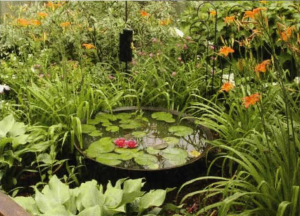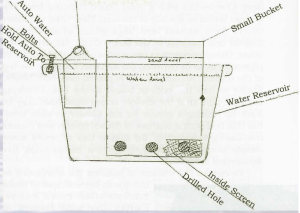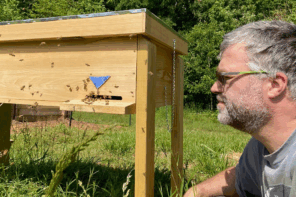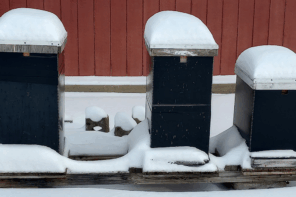This article originally appeared in the Autumn 2016 issue of BEEKeeping Your First Three Years
Bees Need Water and Will Find It…Somewhere.
By: Larry Shreffler
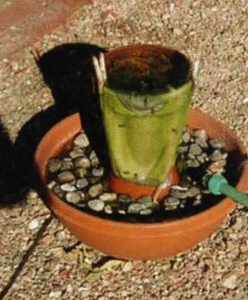 My system. Three containers. The large one on the bottom holds small stones and is partially filled with water. In the center is a smaller pot that houses the water pump. On top of that is another pot. The pump fills the top pot from the water in the bottom, which is filled with a slow drip hose. The cloth provides footing for the bees to get their drink.
My system. Three containers. The large one on the bottom holds small stones and is partially filled with water. In the center is a smaller pot that houses the water pump. On top of that is another pot. The pump fills the top pot from the water in the bottom, which is filled with a slow drip hose. The cloth provides footing for the bees to get their drink.
————————————————————
By: Russ Gilmore
I live in Southwest Ohio. Here’s my water garden in two seasons. The water lily plant shown in the picture is seven or eight years old and even though the water in the container freezes each Winter, the plant is able to “Winter over” and begin sprouting the following Spring.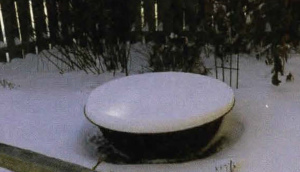
The proper ingredients to my successful water gardens are as follows:
Container – 30 to 50 gallons or more
Water lily – only use hardy water lilies, not hybrid Fish – five or six cheap feeder goldfish (I get mine at Walmart)
The planting process:
• The initial water fill is the most difficult part, as my remote apiary locations do not have water hose access. I may add water once or twice. Obtain a container whose opening is wide enough to capture maximum rainwater.
• Water lilies require full sun. Water lilies do not “like” much movement in the water and the system, as described, does not require oxidation or mechanical filtering.
• Hardy water lily plants are purchased from a nursery. Place in a plastic wash pan packed with good quality topsoil, with a minimum of mulch or compostable matter. Submerge the planted pans to about 18″. As the plant grows, the leaves spread and cover the surface of the water providing two key benefits:
1. A landing pad for bees
2. A cover over the surface of the water to restrict algae growth and evaporation
• At the beginning of the following season, remove the pan, divide the lily, replant in the pan and the other half can be utilized in another container or discarded. I dump the container, rinse out the gunk and start over with a fresh water load. The fish:
• The goldfish are an important element in the loop as they keep the system in balance by consuming mosquito larvae and other microscopic entities. I do not feed the goldfish. I purchase five or six inexpensive “feeder” fish per container and most of them remain alive throughout the warmer months of the year. Occasionally, gold fish “Winter over”; however, I do not count on that.
• Water that stays clear through the year and is available to the bees without the introduction of chemicals and without the need to service the water supply on a regular basis.
——————————————————–
By: Ann Harman
You do have to make a few things but it works, is easy and also can be used successfully in an outyard.
It’s easy to demonstrate but a bit difficult to describe but here goes –
You need a bucket (your choice of a three-gallon or a five-gallon) with lid, A brick or rock to hold lid down – you do NOT want to press the lid in place – it would end up with a vacuum and not work.
You need either: a faucet OR an IV drip line (obtain from friendly veterinarian). The drip line can be trimmed to desired lengths keeping the control of course.
A board – the ideal board is an old oak fence board (not with lots of paint) – farmers usually have some lying around and are glad to give you one.
Make a stand for the bucket – height not too important but three feet high is a convenient height for ease of refilling bucket.
Install either the faucet or the IV drip line on the side of the bucket close to the bottom of the bucket.
Take some tool and scrape or mill or otherwise create a zigzag pattern down the length of the old fence board – shallow in depth since the bees will be standing on the edges of the zigzag drinking from the channel.
Prop and fasten old fence board at a slant (about 45° or a bit more is good) so the top is under the faucet or end of trimmed drip line.
Fill bucket with water. Put lid on so leaves and junk don’t fall into bucket. Put rock on top to keep lid from flying off in a wind.
Adjust drip so that the water enters the zigzag and trickles a bit down the zigzag but the board is dry at the bottom.
For an outyard a five-gallon bucket means you won’t have to refill it very often.
If a suburbanite objects to the appearance of such an item in or close to beeyard, plant bee flowers around it.
——————————————————-
I feed crysalix to my cows, so its container is part one – water reservoir. An automatic tank waterer to keep the water level constant is part two. A plastic bucket that fits between auto waterer and container wall, is part three. The inside bucket has to have holes drilled in its lower sides, and a strip of screen placed inside to keep the sand from falling out. Add sand to ¾” above the water height, attach a hose and level. Adjust sand height to compensate for evaporation and bees will not have to dig too deep.
The downside is it grows grass, moss and whatever. Will not work in freezing temperatures, in fact. The bucket of sand has to really be drained before Winter/Fall.
—————————————————–
By: Patrick Driscoll
I believe I have developed a solution to the problem of providing water for bees (and birds) year round, that I have been using for nearly 15 years. It uses water from the sump pump, which evacuates water from around your house without burning up the sump pump.
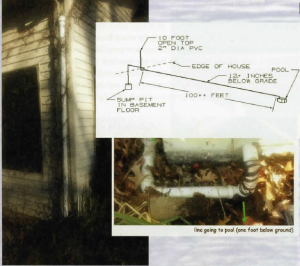 I buried a 2″ PVC line about a foot deep going back over a hundred feet from my house to a plastic pool in the ground. It works all year long because the groundwater around a home is warmed by the heat of the house. Note well: When I first hooked up this system, the sump pump choked, having to push water up from the basement, then out back over one hundred feet. I added a vertical ten foot high OPEN ENDED two inch PVC pipe line at the point where the pipe exits the house, which allows the water column to rise and evacuate air, then gradually fall as the water is pushed out to the back yard. It does not ever flow over the top of the open pipe. I have an ordinary sump pump which has been working the entire time!
I buried a 2″ PVC line about a foot deep going back over a hundred feet from my house to a plastic pool in the ground. It works all year long because the groundwater around a home is warmed by the heat of the house. Note well: When I first hooked up this system, the sump pump choked, having to push water up from the basement, then out back over one hundred feet. I added a vertical ten foot high OPEN ENDED two inch PVC pipe line at the point where the pipe exits the house, which allows the water column to rise and evacuate air, then gradually fall as the water is pushed out to the back yard. It does not ever flow over the top of the open pipe. I have an ordinary sump pump which has been working the entire time!
The snow always melts above ground along the top of this line. Bees are drinking water there year round!








